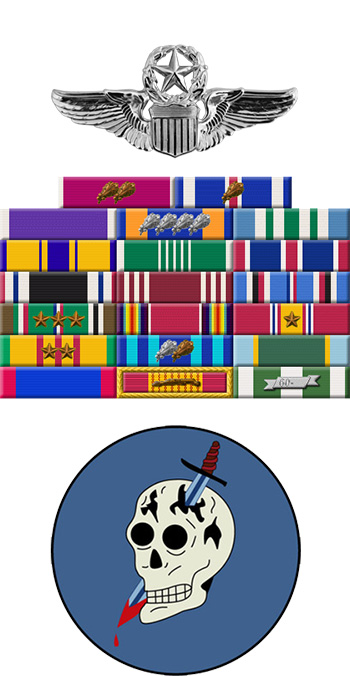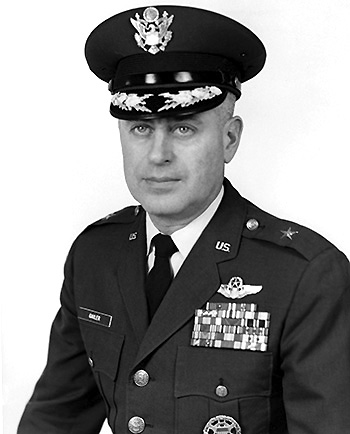
|
Frank L. Gailer, Jr. |
 |
|||
| Rank, Service | ||||
Brigadier General O-7, U.S. Air Force |
||||
| Veteran of: | ||||
|
||||
| Tribute: | ||||
Frank Gailer was born on November 13, 1923, in Bakersfield, California. He enlisted in the Aviation Cadet Program of the U.S. Army Air Forces on June 3, 1942, and was commissioned a 2d Lt and awarded his pilot wings at Eagle Pass, Texas, on August 30, 1943. His first assignment was as a B-25 Mitchell pilot with the 377th Bomb Group at Columbia Army Air Base, South Carolina, from September 1943 to February 1944, followed by P-40 Warhawk training at Thomasville, Georgia, from February to July 1944. Lt Gailer then served as a P-51 Mustang pilot deployed to England with the 363rd Fighter Squadron of the 357th Fighter Group from July 1944 until he was shot down and was taken as a Prisoner of War in Germany on November 27, 1944. During this time he was credited with the destruction of 5.5 enemy aircraft in aerial combat, plus one on the ground while strafing enemy airfields. Lt Gailer was repatriated by the Russians from Stalag Luft I in Germany on April 29, 1945, and returned to American lines on May 14, 1945. His next assignment was as Flight Operations Officer with the 56th Fighter Group at Selfridge Field, Michigan, from June 1945 to June 1946, followed by service with the 23rd Fighter Squadron and then as Commander of the 6th Fighter Wing Headquarters Squadron in Panama from July 1946 to January 1949. Maj Gailer served as Operations Officer and then Deputy Commander of the 6570th Chemical and Ordnance Test Group at Aberdeen Proving Grounds, Maryland, from February 1949 to June 1954, and he then attended Spanish Language training with the Foreign Service Institute in Washington, D.C., from June to December 1954. His next assignment was as an Operations and Training Advisor to the Uruguayan Air Force in Montevideo, Uruguay, from February 1955 to December 1957, followed by service as an International Military Political Affairs Officer, Chief of the Missions Section with the Services and Support Division, Chief of the Latin American Missions Branch, and then Action Officer with the Western Hemisphere Branch Office with Headquarters U.S. Air Force in the Pentagon from January 1958 to August 1963. Col Gailer attended the National War College in Washington, D.C., and deployed to Southeast Asia from August 1963 to June 1964, and then served as Deputy Commander for Training of the 3640th Pilot Training Wing at Laredo AFB, Texas, from July 1964 to September 1965. His next assignment was as Air Commander for the 3640th Pilot Training Wing at Laredo AFB from October 1965 to January 1966, followed by service as Commander of the 3630th Flying Training Wing at Sheppard AFB, Texas, from January 1966 to July 1967. He served as a Faculty Member with the National War College from July 1967 to September 1968, and then served as Commander of the 35th Tactical Fighter Wing at Phan Rang AB, South Vietnam, from September 1968 to August 1969, during which time he flew 235 combat missions in the F-100 Super Sabre. Gen Gailer served as Commander of the 48th Tactical Fighter Wing at RAF Lakenheath, England, from September 1969 to January 1970, followed by service as Vice Commander of 3rd Air Force at South Ruislip AS, England, from February 1970 until his retirement from the Air Force on August 1, 1972. |
||||
|
||||

